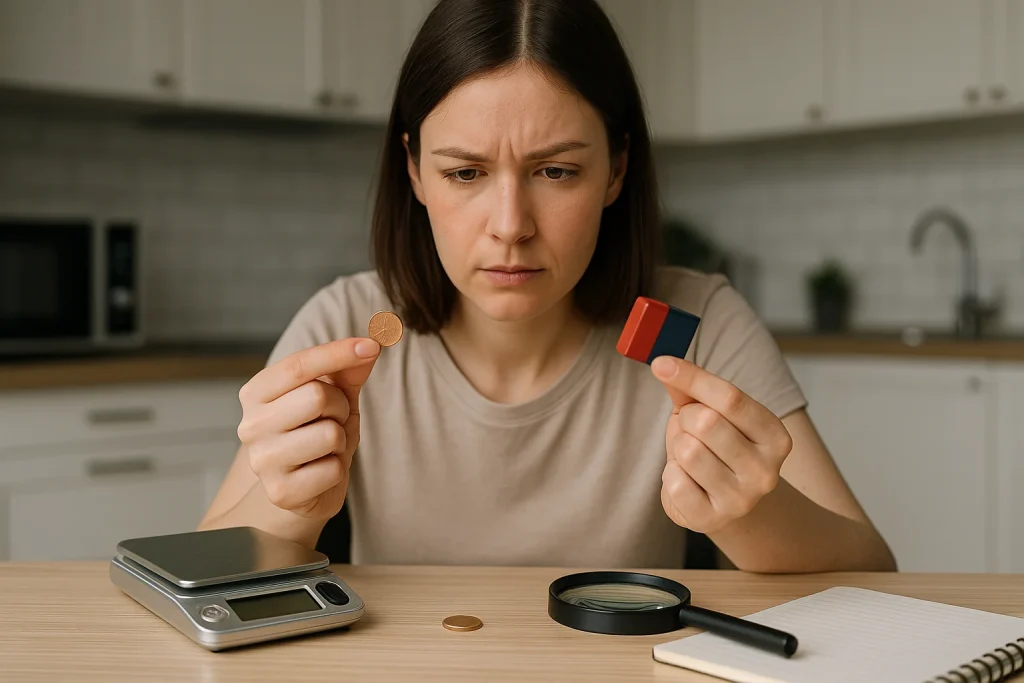The story of the 1943 copper penny isn’t just about a rare coin — it’s a striking example of how a small change in materials during a global crisis turned an everyday object into a numismatic legend. Most coins are forgotten in the jingle of loose change, but this one became a million-dollar marvel.
So, is this particular penny so special? The answer is “yes” and lies in a unique combination of historical necessity, wartime resource management, and an unexpected minting error. But let us take it one step at a time.
Why the U.S. Mint Stopped Using Copper in 1943
In the midst of World War II, copper was considered a critical war material that was needed for shell casings, telephone wires, airplane components, and radio equipment. To support the war effort, the U.S. Mint was ordered to conserve copper by halting its use in coinage — particularly in the one-cent coin, which was produced in huge quantities.
Instead of copper, the Mint began producing Lincoln cents using zinc-coated steel planchets. This metal combination was more available, as well as more affordable and easier to manufacture quickly. The result is the famous 1943 steel cent — a coin that looked completely different from what Americans were used to. Instead of a warm, reddish tone, these pennies had a silvery appearance, often mistaken for dimes.
Fun Fact: First-time collectors are often surprised by the 1943 penny’s silver color. That’s not a special finish — it’s just steel under a thin layer of zinc.
Over 1 billion of these steel cents were produced in 1943, making them common and inexpensive — but they were also the setup for one of the greatest mistakes in U.S. coin history.
How the 1943 Copper Penny Was Born — By Mistake
Even though the U.S. Mint had shifted to steel planchets in 1943, some leftover copper blanks from the previous year didn’t get cleared from the presses. These bronze planchets — typically composed of 95% copper and 5% tin and zinc — were mistakenly fed into the coin-stamping machines. As a result, a very small number of 1943 copper pennies were struck and quietly slipped into circulation.
These weren’t intentional mint products or experimental issues. They were true minting errors — and precisely that makes them so extraordinary in the eyes of collectors.
Over time, numismatic experts confirmed the authenticity of a handful of these coins. While exact numbers are still debated, the currently known and authenticated examples break down as follows:
- Philadelphia Mint (no mint mark): This is where the majority of confirmed specimens come from — about 10 to 13 copper pennies struck here have surfaced and been certified.
- Denver Mint (D mint mark): Only one confirmed example is known — making the 1943-D copper penny one of the rarest U.S. coins ever discovered.
- San Francisco Mint (S mint mark): Like Denver, just one known copper specimen from San Francisco has been verified.
That brings the total number of known 1943 copper pennies to roughly 15, though new examples are occasionally discovered and submitted for authentication.
It’s important to understand: these coins weren’t manufactured to be rare — they are rare because they weren’t supposed to exist at all. Their presence in circulation was a complete fluke, and that’s what drives their sky-high value at auction.
Interesting Fact: Because these coins were unintentional errors, some collectors and experts believe that additional undiscovered examples could still be out there — hidden in old coin jars, tucked away in private estates, or forgotten in long-lost collections.

How to Spot a Real 1943 Copper Penny — And What It Could Be Worth
If you’ve stumbled upon a brownish 1943 penny, don’t start celebrating just yet. While it might look like the rare copper version, there is a high chance it’s not what it seems. The vast majority of 1943 cents were struck in steel — and many are altered to look like their million-dollar copper cousins.
So how can you tell the difference between an authentic 1943 copper penny and a clever fake? Here are a few methods to separating fact from fiction.
Key Physical Tests You Can Do at Home
You don’t need a full laboratory to perform a basic check. Start with these three simple but effective steps:
- Weight Test:
- Authentic 1943 copper penny: around 3.11 grams
- Typical 1943 steel penny: around 2.7 grams
Even a small kitchen scale can help identify fakes based on this difference.
- Magnet Test:
- Steel pennies are magnetic
- Copper pennies are not
If your 1943 penny sticks to a magnet, it’s definitely not copper.
- Color Test (Use with Caution):
- A copper coating on a steel coin can easily fool the eye
- Don’t rely on color alone — it’s the least reliable indicator
Common Fakes and How They’re Made
Given how valuable a genuine 1943 copper penny can be, it is no surprise that counterfeit versions have circulated for decades. In fact, most of the so-called “copper” 1943 pennies people find are either altered coins or outright fakes. Here are the two most common types of counterfeits — and how they’re made:
- Date Alteration
One of the easiest and most deceptive tricks is modifying a 1948 Lincoln cent, which was struck in copper. The counterfeiter carefully shaves part of the “8” in the date to make it resemble a “3,” turning “1948” into what looks like “1943.” To the untrained eye — especially if the coin is worn — the result can seem convincing. But experts and graders spot this kind of tampering immediately.
- Copper-Coated Steel Pennies
Another way involves plating an original 1943 steel penny with copper to fake the appearance of the rare bronze version. Since both types of coins exist and are very similar in shape and detail, this method can seem more plausible — especially if the coin’s surfaces are aged or dirty. However, these fakes still retain their steel core — meaning they stick to a magnet and weigh less than genuine bronze cents.
Pro Tip: Before jumping to conclusions, grab a magnet and a scale. If your coin weighs around 2.7 grams or sticks to a magnet, it’s almost certainly steel. If it passes both tests, use the Coin ID Scanner app to identify the coin, find its details and further compare your coin with real-world verified examples. It’s a great way to get a fast, visual reference. But remember: only certified grading services like PCGS or NGC can truly verify authenticity and unlock top-market value.
What’s a Real 1943 Copper Penny Worth?
Let’s break down the numbers using verified auction data. These aren’t estimations — these are real, documented sales that demonstrate just how valuable the 1943 copper penny can be when certified and in top condition:
| Sale Price | Mint and Grade | Auction House / Year |
| $1,700,000 | Denver (D), MS64BN | Private Sale / 2010 |
| $840,000 | Denver (D), MS64BN | Heritage Auctions / 2021 |
| $504,000 | San Francisco (S), MS63BN | Heritage Auctions / 2020 |
Each of these prices reflects a combination of condition, rarity (especially in the case of the Denver mint), and confirmed provenance.
Fun Fact: Even lower-grade, circulated versions — if proven authentic — can sell for six figures. That’s the power of a true minting mistake.

Where to Look — And What You Might Actually Find
Let’s be honest: the odds of finding an authentic 1943 copper penny in the wild today are extremely low. Most confirmed examples are already graded, auctioned, or locked away in private collections. It’s not the kind of coin you’ll casually stumble upon in your pocket change or a modern penny roll.
But that doesn’t mean all hope is lost. If you enjoy coin hunting — whether casually or as a serious hobby — there are still exciting and valuable coins out there. Old family coin jars, inherited collections, estate sales, and unsearched bulk coin bags are all potential treasure troves.
Realistic Finds Worth Hunting For:
While the 1943 copper penny is the holy grail, these coins are much more within reach — and can still be worth thousands:
- 1944 Steel Cent: A “reverse error” where steel blanks were mistakenly used in 1944 after copper returned to circulation. One sold for over $100,000.
- 1955 Doubled Die Obverse: Famous for its dramatic doubling on the date and lettering. Values range from $1,000 to $15,000+, depending on condition.
- 1983 Doubled Die Reverse: Less famous but still valuable, with doubling on the reverse lettering — fetches several hundred to a few thousand dollars.
- 1969-S Doubled Die Obverse: One of the rarest and most dramatic doubling errors. Some examples have sold for up to $35,000.
- 1992 Close AM: A modern but rare variation where the “A” and “M” in “AMERICA” are closer together than normal. Values start at $1,000+.
So yes — while you are unlikely to find the legendary penny, you can still uncover rare pieces that excite collectors and command real value.
The Coin That Changed How We See Mistakes
The story of the 1943 copper penny is more than a quirky footnote in mint history — it’s a reminder that even the smallest oversight can create something truly extraordinary.
And for collectors, this story is proof that knowledge matters: recognizing key features, knowing which years to watch for, and using tools like Coin ID Scanner to examine your finds — all of it increases your chances of spotting something special. Frankly speaking, you may never uncover a million-dollar coin. But you just might find something rare, valuable, and uniquely yours — and that will be a jewel in itself.



